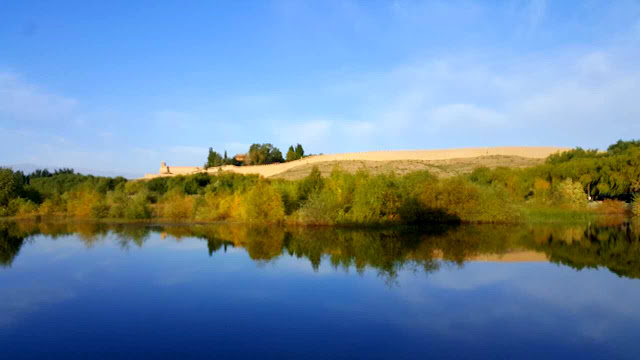 We spent a lot of time in a bus today driving from
Zhangye Danxia Landform Geological Park (click
here to read more) along the Hexi Corridor (I thought
that they were saying “Hershey” until I saw it written if that helps you
understand how it is pronounced. Fun
fact: in Mandarin the “x” makes a soft “sh” sound.*) on the way to the Jaiyu
Pass. What is so important about this
pass you may be asking yourself. I will
tell you. Jia Ya Guan Fortress and the Western end of the Wall**. Not to
mention the only access to water in a thousand square miles. It is kind of a
big deal.
We spent a lot of time in a bus today driving from
Zhangye Danxia Landform Geological Park (click
here to read more) along the Hexi Corridor (I thought
that they were saying “Hershey” until I saw it written if that helps you
understand how it is pronounced. Fun
fact: in Mandarin the “x” makes a soft “sh” sound.*) on the way to the Jaiyu
Pass. What is so important about this
pass you may be asking yourself. I will
tell you. Jia Ya Guan Fortress and the Western end of the Wall**. Not to
mention the only access to water in a thousand square miles. It is kind of a
big deal.
Let’s just take a moment to let the fact sink
in that Jia Ya Guan Fortress is both
the western starting point if the Ming dynasty version of the Great Wall of
China (over a thousand miles from Beijing) but also a vital crossroads on the
ancient Silk Road. The fortress and this
section of the Wall don’t meet us anymore.
The remains of the wall of south of the city center and the fortress is
in the north.
It was
built during the Ming Dynasty (like much of the Wall) around in the late 12th
century. For hundreds of years it served
as one of the greatest waypoints of the Silk Road. We were told that over 80%
of the Jia Ya Guan Fortress was original. That it hasn't been restored. If that is true then the preservation has been incredible. Most of what we were walking around and on
looked and felt new. Well, maybe not new
but at least not ancient. The steps were
even (unlike in the Great Wall of Beijing) and everything was level.
A
different kind of Wall
The
wall here looks completely different that the four other sections that I have
seen in Beijing. In Beijing the Wall is
built with smooth grey stone blocks and the gatehouses that jut up every
hundred yards or so are built on square straight up and down lines. The wall in are sand colored, perfectly
blending into the desert landscape they are traversing. The gatehouses are vaguely trapezoid shaped
and have a much more central Asian feel to them. The wall extends all the way to the Beida
River Gorge.
An
oasis
There
is a small lake fed by a spring in front of the fortress forming an important oasis. Today is a magnet to for everyone who wants a
picture of the fortress reflecting in it but it is the historical basis for its
location. This spring fed lake along with the Beida River gave the Ming
government almost total control of the water in the region. With no access to water it was impossible to
an army of any size to attempt to take the Fortress/ invade China. It was strengthened at one point to deflect a
the army of a war chief who basically died of old age while planning his invasion
of China.
Visiting
it now is a slightly jarring experience.
There were thousands of people milling along the paths with us not to
mention a few hundred actors in traditional costumes playing the part of
soldiers marching around. But yet again,
once you got to the top of the wall of the Fortress it was easy to imagine the
world as it was a thousand years ago.
The Gobi desert stretch’s in front of you impenetrable and you are
flanked on either side by mountain ranges. It is as if the planet itself is
funneling travelers to this one point.
You can almost feel the relief of the Eastern bound travelers upon
seeing the fortress or hold your breath in fearful anticipation with the
Westward travelers about to go forth into the Gobi.
A note
on crowds and Golden Week
Travelling
in China isn’t usually this crowded. Unfortunately,
one of the downsides to working in China is the fact that my breaks from
teaching are exactly when the rest of the countries are as well. “Golden week” actually happens twice a year in
China. Once during Spring Festival/ Chinese
New Year and one for National Day (October first). Chinese workers are given three days of paid
leave connected to a weekend so that everyone has seven days off. During Spring
Festival most people return home to see their families in the countryside. During the National Day holiday, they
travel. There are over 580 million
people travelling during Golden Week this year.
It makes the sheer numbers of people in the crowds make sense. Pro tip: Do not visit China at this time if
you cannot handle crowds.
My
husband and I ended our trip by walking a bit into the desert, past the crowds,
past the camels carrying tourists, and looking out into the distance as if we
could see the echoes of those long ago traders.
 *I realized that it is dangerous to throw out
90% of one’s entire knowledge of a language into one blog post but I am
reckless like that.
*I realized that it is dangerous to throw out
90% of one’s entire knowledge of a language into one blog post but I am
reckless like that.
**the fort is transliterated about 10
different ways. I am using the spelling my friend Hunter gave me because he is Chinese,
is teacher of Mandarin, and speaks excellent English. Let’s all just agree that
the spelling is debatable and move on.
Click here to read about starting out on the
Silk Road
Click here to read about day two on the Silk Road
and the Terracotta Warriors
Would you travel in China during Golden Week?













No comments:
Post a Comment
Tell me what you think!